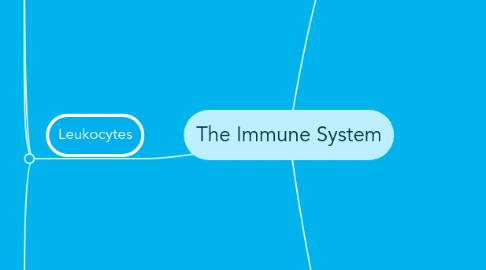
1. Leukocytes
1.1. diapedesis
1.1.1. when a white blood cell travels through capillaries then arrives at point of infection, they send a signal then ooze through the capillary to heal
1.2. phagocytes
1.2.1. phagocytosis
1.2.2. eat the viruses in the cell (as opposed to the natural killer cells)
1.2.3. natural killer cells
1.2.3.1. circulate in the blood and kill viruses, bacteria and cancerous cells
1.2.3.2. MORE INFO IN INNATE IMMUNITY SECTION
1.2.4. 4 kinds
1.2.4.1. neutrophils
1.2.4.1.1. move around bloodstream; quickly get to action
1.2.4.1.2. when they eat infected cells, they die and become pus
1.2.4.2. macrophages
1.2.4.2.1. BIG and don't travel a lot
1.2.4.2.2. they usually stay put around your vital organs
1.2.4.2.3. they can detect rogue (cancerous) cell and alert other immune cells
1.2.4.2.4. Antigen-presentation
1.2.4.3. dendritic cells
1.2.4.3.1. "mailman"
1.2.4.3.2. they stay on the outside of your body
1.2.4.3.3. eat pathogen and record the information then bring the info back to your thymus
1.2.4.3.4. allows things to move from the innate immune system to the acquired immune system
1.2.4.4. natural killer cells
1.2.4.4.1. circulate in blood and kill viruses, bacteria and blood cells
1.2.4.4.2. kill other body cells
1.2.4.4.3. the only phagocytes to destroy and attack other human cells
1.2.4.4.4. humans have MHC 1 when they are healthy
1.3. lymphocytes
1.3.1. B Cells
1.3.1.1. covered in antibodies that can attach to specific antigens
1.3.1.2. memory B cell
1.3.1.2.1. when pathogen comes, B cell reprodeces and makes effector and memory cells (see hank green vid for illustration)
1.3.1.3. effector/plasma cell
1.3.1.3.1. use antibodies as a blueprint to make a crap ton of anitbodies for that specific pathogen 2/sec
1.3.1.4. Mature in bone marrow
1.3.2. T Cells
1.3.2.1. Cytotoxic T Cells
1.3.2.1.1. NOT phagocyes
1.3.2.1.2. release enzymes that kll the cell
1.3.2.1.3. defend against the infected cell
1.3.2.1.4. helps with suicide
1.3.2.1.5. KILLER CELLS
1.3.2.2. Memory T cells
1.3.2.2.1. have previously encountered and responded to antigen
1.3.2.2.2. cells that keep track of how THEY killed a pathogen (chicken pox)
1.3.2.3. helper T cells
1.3.2.3.1. attach to B cells to tell genetic material of pathogen
1.3.2.3.2. release T cell cytokineses
1.3.2.3.3. they kinda call the shots for the whole immune system
1.3.2.4. mature in thymus
1.3.2.4.1. coordinate the immune system and attack
2. Adaptive/Acquired Immunity
2.1. SUPER ELITE DOUBLE SECRET STRIKE FORCE DELTA
2.2. Active Immunity
2.2.1. when your body has to recognize antigens and produce antibodies
2.2.2. vaccines
2.2.2.1. injected weakened or dead viruses so your body can become immune to the virus
2.3. vertebrates only
2.4. develops more slowly to allow to learn about the pathogen before attacking
2.5. humoral response
2.5.1. activation of B cells
2.6. cell-mediated immune response
2.6.1. activation of cytotoxic T Cells
2.7. Antigens
2.7.1. signs that cause your immune system to create an antibody against detected pathogen
2.7.2. "antibody generator"
2.7.3. antibodies...
2.7.3.1. not cells
2.7.3.2. produced by B cells
2.7.3.3. they cannot kill
2.7.3.3.1. however they can swarm around invaders making it very difficult for them to move
2.7.3.3.2. they can also attach themselves to the bad guys and send out chemical messages to phagocytes
2.8. lymphocytes
2.8.1. T Cells
2.8.1.1. SEE DESCRIPTION IN LEUKOCYTES
2.8.2. B Cells
2.8.2.1. SEE DESCRIPTION IN LEUKOCYTES
3. Innate Immunity
3.1. Passive Immunity
3.1.1. injected with antibodies or given from your mother
3.1.1.1. your body gets antibodies without actually making them
3.1.1.2. when you are a baby
3.1.1.2.1. placenta
3.1.1.2.2. breast milk
3.2. every animal has this
3.3. also called non specific
3.3.1. faster?
3.4. protects against ALL pathogens
3.4.1. barrier defences
3.4.1.1. 1st line of defense
3.4.1.2. mucous membranes
3.4.1.3. secretions
3.4.1.4. skin
3.4.1.5. tears
3.4.1.6. sweat
3.4.2. internal defences
3.4.2.1. 2nd line of defense to barrier defenses
3.4.2.2. phagocytes
3.4.2.2.1. SEE DESCRIPTION IN LEUKOCYTES
3.4.2.3. inflammation/ inflammatory response
3.4.2.3.1. response to damage by injury or infection
3.4.2.3.2. mast cells
3.5. leukocytes
3.5.1. SEE LEUKOCYTE DESCRIPTIONS
